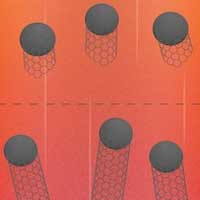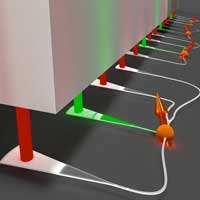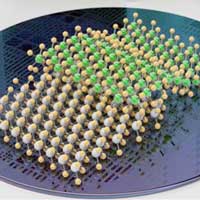 The first experimental observation of three-dimensional magnetic 'vortex rings' provides fundamental insight into intricate nanoscale structures inside bulk magnets, and offers fresh perspectives for magnetic devices.
The first experimental observation of three-dimensional magnetic 'vortex rings' provides fundamental insight into intricate nanoscale structures inside bulk magnets, and offers fresh perspectives for magnetic devices.
Monday, November 30, 2020
Magnetic vortices come full circle
 The first experimental observation of three-dimensional magnetic 'vortex rings' provides fundamental insight into intricate nanoscale structures inside bulk magnets, and offers fresh perspectives for magnetic devices.
The first experimental observation of three-dimensional magnetic 'vortex rings' provides fundamental insight into intricate nanoscale structures inside bulk magnets, and offers fresh perspectives for magnetic devices.
Raman holography
 Scientists report on a novel Raman holographic technique capable of tracking individual particles in 3D volumes from one single image.
Scientists report on a novel Raman holographic technique capable of tracking individual particles in 3D volumes from one single image.
How to store cipher data in magnetic skyrmions
 Scientists propose direct magnetic writing of skyrmions, i.e. magnetic quasiparticles, and skyrmion lattices, within which it is possible to encode, transmit, process information, and produce topological patterns with a resolution of less than 100 nanometers.
Scientists propose direct magnetic writing of skyrmions, i.e. magnetic quasiparticles, and skyrmion lattices, within which it is possible to encode, transmit, process information, and produce topological patterns with a resolution of less than 100 nanometers.
How does the spider spin its self-assembled silk?
 Researchers report on a new model for spider silk assembly. The key to spider silk 'spinning' is a combination of acidification and a process known as liquid-liquid phase separation, or LLPS.
Researchers report on a new model for spider silk assembly. The key to spider silk 'spinning' is a combination of acidification and a process known as liquid-liquid phase separation, or LLPS.
Researchers run a 'speed test' to boost production of carbon nanotubes
 Researchers have investigated the procedure for catalyst delivery used in the most common method of carbon nanotube production, chemical vapor deposition (CVD), offering what they call a simple and elegant way to boost productivity and pave the way for cheaper and more accessible nanotube-based technology.
Researchers have investigated the procedure for catalyst delivery used in the most common method of carbon nanotube production, chemical vapor deposition (CVD), offering what they call a simple and elegant way to boost productivity and pave the way for cheaper and more accessible nanotube-based technology.
A shapeshifting material based on inorganic matter
 By embedding titanium-based nanosheets in water, scientists have created a material using inorganic materials that can be converted from a hard gel to soft matter using temperature changes.
By embedding titanium-based nanosheets in water, scientists have created a material using inorganic materials that can be converted from a hard gel to soft matter using temperature changes.
Sunday, November 29, 2020
Nanoscopic barcodes set a new science limit
 Imagine shrinking barcodes a million times, from millimetre to nanometre scale, so that they could be used inside living cells to label, identify and track the building blocks of life or, blended into inks to prevent counterfeiting. This is the frontier of nanoengineering, requiring fabrication and controlled manipulation of nanostructures at atomic level.
Imagine shrinking barcodes a million times, from millimetre to nanometre scale, so that they could be used inside living cells to label, identify and track the building blocks of life or, blended into inks to prevent counterfeiting. This is the frontier of nanoengineering, requiring fabrication and controlled manipulation of nanostructures at atomic level.
Saturday, November 28, 2020
Freeze like a star! Web exhibition explores the mysteries of the quantum world
 Colder than in outer space, higher pressure than 30 sperm whales on a stamp, and super magnets that could hold two Eiffel Towers: The search for new quantum materials - the materials of the day after tomorrow - is taking place today under extreme conditions. Yet it is often difficult to understand what the researchers actually do in their high-performance laboratories.
Colder than in outer space, higher pressure than 30 sperm whales on a stamp, and super magnets that could hold two Eiffel Towers: The search for new quantum materials - the materials of the day after tomorrow - is taking place today under extreme conditions. Yet it is often difficult to understand what the researchers actually do in their high-performance laboratories.
Game-changer in thermoelectric materials: decoupling electronic and thermal transport
 A new study overcomes a major challenge of thermoelectric materials, which can convert heat into electricity and vice versa, improving conversion efficiency by more than 60%.
A new study overcomes a major challenge of thermoelectric materials, which can convert heat into electricity and vice versa, improving conversion efficiency by more than 60%.
Friday, November 27, 2020
Physicists invent printable superconducting devices
 Superconducting devices such as SQUIDS (Superconducting Quantum Interferometry Device) can perform ultra-sensitive measurements of magnetic fields. Physicsts invented a method to 3D-print these and other superconducting devices in minutes.
Superconducting devices such as SQUIDS (Superconducting Quantum Interferometry Device) can perform ultra-sensitive measurements of magnetic fields. Physicsts invented a method to 3D-print these and other superconducting devices in minutes.
Thursday, November 26, 2020
Taking correlated quantum Hall physics to the third dimension
 Scientists have discovered a new strongly correlated electronic state in a three-dimensional metal that is a close relative of the two-dimensional quantum Hall state.
Scientists have discovered a new strongly correlated electronic state in a three-dimensional metal that is a close relative of the two-dimensional quantum Hall state.
Microswimmers move like moths to the light
 Researchers have studied an impressive behavior of synthetic microswimmers: as soon as the photocatalytic particles leave an illuminated zone, they flip independently and swim back into the light.
Researchers have studied an impressive behavior of synthetic microswimmers: as soon as the photocatalytic particles leave an illuminated zone, they flip independently and swim back into the light.
Improved 3D printing for aerospace composites using nanocarbon additives from oil waste
 The nanocarbon additive to aluminum powder, obtained from the products of processing associated petroleum gas, will improve the quality of 3D printed aerospace composites by increasing the hardness of products by 1.5 times.
The nanocarbon additive to aluminum powder, obtained from the products of processing associated petroleum gas, will improve the quality of 3D printed aerospace composites by increasing the hardness of products by 1.5 times.
Lanthanide nanocrystals brighten molecular triplet excitons
 Scientists have developed an approach to improve the generation and luminescent harvesting of molecular triplets by coupling them with lanthanide-doped nanoparticles. This innovation provides new insights on lanthanide nanocrystal-molecule interaction in the optoelectronic field.
Scientists have developed an approach to improve the generation and luminescent harvesting of molecular triplets by coupling them with lanthanide-doped nanoparticles. This innovation provides new insights on lanthanide nanocrystal-molecule interaction in the optoelectronic field.
Wednesday, November 25, 2020
Researchers create nanoscale slalom course for electrons
 Researchers have created a serpentine path for electrons, imbuing them with new properties that could be useful in future quantum devices.
Researchers have created a serpentine path for electrons, imbuing them with new properties that could be useful in future quantum devices.
The quantum sensing abilities of nanodiamonds may help detect disease earlier
 The quantum sensing abilities of nanodiamonds can be used to improve the sensitivity of paper-based diagnostic tests, potentially allowing for earlier detection of diseases such as HIV.
The quantum sensing abilities of nanodiamonds can be used to improve the sensitivity of paper-based diagnostic tests, potentially allowing for earlier detection of diseases such as HIV.
Phytoplankton disturbed by nanoparticles
 Researchers have investigated the effects of nanosilver, currently used in almost 450 products for its antibacterial properties, on the algae known as Poterioochromonas malhamensis. The results show that nanosilver and its derivative, ionic silver, disturb the alga's entire metabolism. Its membrane becomes more permeable, the cellular reactive oxygen species increases and photosynthesis is less effective.
Researchers have investigated the effects of nanosilver, currently used in almost 450 products for its antibacterial properties, on the algae known as Poterioochromonas malhamensis. The results show that nanosilver and its derivative, ionic silver, disturb the alga's entire metabolism. Its membrane becomes more permeable, the cellular reactive oxygen species increases and photosynthesis is less effective.
Detecting bacteria with fluorescent nanosensors
 Scientists have developed a new method for detecting bacteria and infections. They use fluorescent nanosensors to track down pathogens faster and more easily than with established methods.
Scientists have developed a new method for detecting bacteria and infections. They use fluorescent nanosensors to track down pathogens faster and more easily than with established methods.
Tuesday, November 24, 2020
Animal-free method predicts nanoparticle toxicity for safer industrial materials
 Researchers have developed a novel animal-free method to predict the toxic effect of nanoparticles to the human lung. The method aims to enable the safety-by-design development of safer industrial materials.
Researchers have developed a novel animal-free method to predict the toxic effect of nanoparticles to the human lung. The method aims to enable the safety-by-design development of safer industrial materials.
Sound waves power new advances in drug delivery and smart materials
 Pioneering research shows how high-frequency sound waves can help build smart materials, new nanoparticles and deliver drugs to the lungs for painless, needle-free vaccinations.
Pioneering research shows how high-frequency sound waves can help build smart materials, new nanoparticles and deliver drugs to the lungs for painless, needle-free vaccinations.
Replicating surfaces, right down to the sub-atomic scale
 Researchers demonstrate an alternative sputter deposition-based approach for the replication of atomic-scale features that is suited for a very broad range of amorphous alloys, thereby dramatically extending the available chemistries.
Researchers demonstrate an alternative sputter deposition-based approach for the replication of atomic-scale features that is suited for a very broad range of amorphous alloys, thereby dramatically extending the available chemistries.
Detecting molecules with infrared laser pulses
 Scientists demonstrate laser light in the mid-infrared range with tailor-made quantum cascade lasers.
Scientists demonstrate laser light in the mid-infrared range with tailor-made quantum cascade lasers.
Monday, November 23, 2020
Direct visualization of quantum dots reveals shape of quantum wave function
 Researchers used a scanning tunneling microscope to visualize quantum dots in bilayer graphene, an important step toward quantum information technologies.
Researchers used a scanning tunneling microscope to visualize quantum dots in bilayer graphene, an important step toward quantum information technologies.
World's smallest atom-memory unit created
 Faster, smaller, smarter and more energy-efficient chips for everything from consumer electronics to big data to brain-inspired computing could soon be on the way after engineers created the smallest memory device yet.
Faster, smaller, smarter and more energy-efficient chips for everything from consumer electronics to big data to brain-inspired computing could soon be on the way after engineers created the smallest memory device yet.
Self-diagnostic carbon nanocomposites
 Researchers have created multifunctional materials through the addition of carbon nanoparticles to polymer matrices, designed to allow self-diagnostic monitoring through an inexpensive technique.
Researchers have created multifunctional materials through the addition of carbon nanoparticles to polymer matrices, designed to allow self-diagnostic monitoring through an inexpensive technique.
Researchers overcome barriers for bio-inspired solar energy harvesting materials
 Inspired by nature, researchers demonstrate a synthetic strategy to stabilize bio-inspired solar energy harvesting materials. Their findings could be a significant breakthrough in functionalizing molecular assemblies for future solar energy conversion technologies.
Inspired by nature, researchers demonstrate a synthetic strategy to stabilize bio-inspired solar energy harvesting materials. Their findings could be a significant breakthrough in functionalizing molecular assemblies for future solar energy conversion technologies.
Vibrational encounters - phonon polaritons meet molecules
 Scientists have employed a spectroscopic nanoimaging technique to study how infrared nanolight and molecular vibrations interact with each other. The images reveal that vibrational strong coupling can be achieved, which is a phenomenon that recently attracts wide attention for its potential use to control fundamental physical and chemical material properties.
Scientists have employed a spectroscopic nanoimaging technique to study how infrared nanolight and molecular vibrations interact with each other. The images reveal that vibrational strong coupling can be achieved, which is a phenomenon that recently attracts wide attention for its potential use to control fundamental physical and chemical material properties.
Strain engineering of 2D semiconductors and graphene
 Strain engineering can significantly manipulate the two-dimensional (2D) materials' electronic and optical properties, which endow it the potential applications in optoelectronics and nanophotonics.
Strain engineering can significantly manipulate the two-dimensional (2D) materials' electronic and optical properties, which endow it the potential applications in optoelectronics and nanophotonics.
Researchers find conformational disorder tuning charge carrier mobility in 2D perovskites
 Researchers have synthesized a series of 2D organic-inorganic hybrid perovskites films with large organic spacer cations, and found that mobility and broadband emission showed strong dependence on the molecular conformational order of organic cations.
Researchers have synthesized a series of 2D organic-inorganic hybrid perovskites films with large organic spacer cations, and found that mobility and broadband emission showed strong dependence on the molecular conformational order of organic cations.
Contact lenses for diagnostic and therapeutic use
 Specially engineered contact lenses use tears to monitor patient health.
Specially engineered contact lenses use tears to monitor patient health.
Perfect imperfection: Electrode defects boost resistive memory efficiency
 Researchers have studied the impact of electrode surface morphology on the properties of a resistive switching memory cell. It turned out that thicker electrodes have greater surface roughness and are associated with markedly better memory cell characteristics.
Researchers have studied the impact of electrode surface morphology on the properties of a resistive switching memory cell. It turned out that thicker electrodes have greater surface roughness and are associated with markedly better memory cell characteristics.
Controlling fully integrated nanodiamonds
 Physicists have succeeded in fully integrating nanodiamonds into nanophotonic circuits and at the same time addressing several of these nanodiamonds optically. The study creates the basis for future applications in the field of quantum sensing schemes or quantum information processors.
Physicists have succeeded in fully integrating nanodiamonds into nanophotonic circuits and at the same time addressing several of these nanodiamonds optically. The study creates the basis for future applications in the field of quantum sensing schemes or quantum information processors.
Unlocking cheaper, sustainable chemicals
 A new technique to make cheaper more efficient biological enzyme hybrids could have valuable applications in future water recycling, targeted drug manufacturing and other industries.
A new technique to make cheaper more efficient biological enzyme hybrids could have valuable applications in future water recycling, targeted drug manufacturing and other industries.
Saturday, November 21, 2020
From lab to industry? Ideally ordered porous titania films, made at scale
 Researchers have realized high-throughput production of thin, ordered through-hole membranes of titanium dioxide.
Researchers have realized high-throughput production of thin, ordered through-hole membranes of titanium dioxide.
Friday, November 20, 2020
New insights into memristive devices by combining incipient ferroelectrics and graphene
 Materials scientists analyzed the behaviour of strontium titanium oxide, a platform material for memristor research and used the 2D material graphene to probe it.
Materials scientists analyzed the behaviour of strontium titanium oxide, a platform material for memristor research and used the 2D material graphene to probe it.
One-way street for electrons
 Scientists observe directed energy transport between neighbouring molecules in a nanomaterial.
Scientists observe directed energy transport between neighbouring molecules in a nanomaterial.
Light-controlled nanomachine controls catalysis
 Researchers have now managed to control a catalysis reaction using a light-controlled motor. This takes us one step closer to realising the vision of a nano factory in which combinations of various machines work together, as is the case in biological cells.
Researchers have now managed to control a catalysis reaction using a light-controlled motor. This takes us one step closer to realising the vision of a nano factory in which combinations of various machines work together, as is the case in biological cells.
Specific isotope-responsive breathing transition in flexible MOFs
 Researchers have introduced a novel responsive system, capable of molecular recognition of physicochemically similar mixtures, such as isotopes.
Researchers have introduced a novel responsive system, capable of molecular recognition of physicochemically similar mixtures, such as isotopes.
Synthesizing a vertical 2D layered fused aromatic ladder structure
 Scientists have designed and synthesized a vertical two-dimensional (2D) layered structure to develop materials that exhibit excellent performance in terms of gas storage and for the removal of toxic substances.
Scientists have designed and synthesized a vertical two-dimensional (2D) layered structure to develop materials that exhibit excellent performance in terms of gas storage and for the removal of toxic substances.
More Moore: Development of ultra-thin semiconductor electrodes
 Researchers have succeeded in patterning a two-dimensional (2D) metal electrode into desired shapes on the 4-inch diameter silicon substrate.
Researchers have succeeded in patterning a two-dimensional (2D) metal electrode into desired shapes on the 4-inch diameter silicon substrate.
Staying ahead of the curve with 3D curved graphene
 By controlling the curvature, researchers have successfully retained the electrical properties of 2D graphene in a 3D structure.
By controlling the curvature, researchers have successfully retained the electrical properties of 2D graphene in a 3D structure.
Thursday, November 19, 2020
Predicting forces between oddly shaped nanoparticles
 Simplified model of van der Waals forces will allow previously impossible simulations of how faceted nanoparticles self-assemble into larger structures.
Simplified model of van der Waals forces will allow previously impossible simulations of how faceted nanoparticles self-assemble into larger structures.
A nanomesh pressure sensor that can be attached directly to the skin
 An imperceptible thin-film sensor to record movement and the sense of touch.
An imperceptible thin-film sensor to record movement and the sense of touch.
Mystery solved: a 'new kind of electrons'
 Why do certain materials emit electrons with a very specific energy? This has been a mystery for decades - scientists have now found an answer.
Why do certain materials emit electrons with a very specific energy? This has been a mystery for decades - scientists have now found an answer.
Versatile building blocks make structures with surprising mechanical properties
 The subunits could be robotically assembled to produce large, complex objects, including cars, robots, or wind turbine blades.
The subunits could be robotically assembled to produce large, complex objects, including cars, robots, or wind turbine blades.
Combining machine learning analysis with 2D material spectroscopy
 Researchers propose a recognition method to distinguish the monolayer continuous film and random defect areas of two-dimensional (2D) semiconductors using machine learning methods with Raman signals.
Researchers propose a recognition method to distinguish the monolayer continuous film and random defect areas of two-dimensional (2D) semiconductors using machine learning methods with Raman signals.
Improving quantum dot interactions, one layer at a time
 Scientists have found a way to control an interaction between quantum dots that could lead to more efficient solar cells.
Scientists have found a way to control an interaction between quantum dots that could lead to more efficient solar cells.
Scientists age quantum dots in a test tube
 Researchers have proposed a simple and convenient way to obtain arbitrarily sized quantum dots required for physical experiments via chemical aging.
Researchers have proposed a simple and convenient way to obtain arbitrarily sized quantum dots required for physical experiments via chemical aging.
Researchers find a completely new way to control the conductivity of materials at nanoscale
 The new approach is based on exploiting 'hidden' irregularities at the atomic level, so-called anti-Frenkel defects. The researchers have managed to create such defects themselves, thus enabling an insulating material to become electrically conducting.
The new approach is based on exploiting 'hidden' irregularities at the atomic level, so-called anti-Frenkel defects. The researchers have managed to create such defects themselves, thus enabling an insulating material to become electrically conducting.
Stacking 2D materials to reduce computing power consumption
 Scientists have designed a 2D material-based multi-stacked structure comprising tungsten disulfide layer sandwiched between hexagonal boron nitride layers that has potential for reducing circuit design complexity and power consumption.
Scientists have designed a 2D material-based multi-stacked structure comprising tungsten disulfide layer sandwiched between hexagonal boron nitride layers that has potential for reducing circuit design complexity and power consumption.
Subscribe to:
Posts (Atom)
